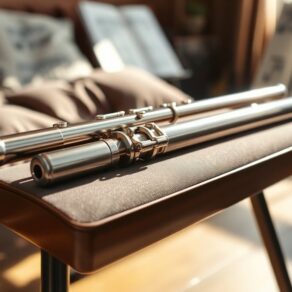Developing a structured practice routine is fundamental for flute players aspiring to enhance their musical proficiency. From setting specific objectives to refining technical skills, each element contributes to a well-rounded practice regimen. However, the key lies in not just the routine itself but in how it is executed. By understanding the nuances of effective practice techniques and incorporating strategies that promote growth, flutists can elevate their playing to new heights. The journey to mastery begins with a deliberate and intentional approach – one that unveils the true potential of dedicated practice.
Key Takeaways
- Set clear, measurable practice goals for focused improvement.
- Establish a consistent practice schedule to enhance progress.
- Incorporate warm-up exercises to prepare body and mind.
- Focus on tone development through breath control and dynamics.
- Work on technique, articulation, intervals, and rhythmic patterns for skill enhancement.
Setting Clear Practice Goals
When embarking on a fruitful flute practice routine, setting clear and specific practice goals is essential for maximizing progress and efficiency. Goal measurement and progress tracking are key components in ensuring that your practice sessions are effective and purposeful. By establishing measurable goals, such as mastering a new scale or improving tone quality, you provide yourself with a clear direction and purpose for each practice session.
Practice accountability plays a crucial role in goal setting. Hold yourself accountable by tracking your progress and reflecting on areas where improvement is needed. This can be done through keeping a practice journal or using apps that help monitor your practice time and achievements. By regularly reviewing your progress, you can adjust your goals accordingly and stay motivated to push yourself further.
Effective time management is another vital aspect of setting clear practice goals. Allocate specific time slots for different aspects of your practice, whether it be scales, etudes, or repertoire. By breaking down your practice session into smaller, focused segments, you can ensure that all areas of your playing receive attention and improvement.
Establishing a Consistent Schedule
To enhance your flute practice routine and ensure consistent progress, establishing a structured and unwavering schedule is paramount. Time management plays a crucial role in carving out dedicated practice sessions. By setting aside specific blocks of time each day for practice, you create a routine that fosters consistency. Consistency is key to improvement, as regular practice allows you to build upon your skills and knowledge steadily.
When establishing your practice schedule, consider your daily commitments and peak concentration periods. This will help you identify the best times to practice when you are most focused and least likely to be interrupted. By aligning your practice schedule with your natural rhythms, you can make the most out of your practice sessions.
The table below offers a simplified example of how you can structure your practice schedule:
| Day | Time | Focus |
|---|---|---|
| Monday | 4:00-5:00 PM | Scales and Technique |
| Tuesday | 7:30-8:30 AM | Tone Quality |
| Wednesday | 6:00-7:00 PM | Repertoire Practice |
Goal setting is another essential component of maintaining a consistent schedule. Setting specific goals for each practice session can help keep you motivated and focused. Whether it's mastering a challenging passage or improving your tone, having clear objectives will drive your practice sessions forward. By combining effective time management, consistency, goal setting, and motivation, you can establish a practice routine that maximizes your progress as a flute player.
Incorporating Warm-Up Exercises
In preparing for flute practice sessions, incorporating a series of purposeful warm-up exercises is essential to optimize your playing and ensure a strong foundation for the rest of your practice routine. Warm-ups serve as the gateway to a successful practice session, helping you focus, center your mind, and prepare your body for the demands of playing the flute.
Breath control lies at the heart of flute playing. To kickstart your warm-up routine, begin with breathing exercises. Deep breathing not only oxygenates your body but also calms your mind, setting the tone for mindful practice. Try exercises like breathing in for four counts, holding for four, and exhaling for four, gradually increasing the count as you progress. This will enhance your breath control, allowing for sustained phrases and dynamic nuances in your playing.
Next, focus on finger dexterity. Start with simple finger lifts and finger presses to warm up the muscles in your hands and improve coordination. Move on to scales or arpeggios, gradually increasing the speed to challenge your fingers. This will enhance your agility and precision when navigating through complex passages during your practice session.
Focusing on Tone Development
Developing a rich and resonant tone on the flute is a nuanced process that requires attention to breath support, embouchure control, and listening skills. Tone quality is the cornerstone of a flutist's sound, and it can be enhanced through various breathing techniques. Proper breath support, where the air is directed efficiently through the instrument, is vital for producing a full-bodied tone. Practice breathing exercises like long tones and breathing gym routines to strengthen your diaphragm and improve control over your airstream.
In addition to breath support, mastering dynamics and phrasing techniques is crucial for achieving a well-rounded tone. Dynamics, the variations in loudness and softness, add depth and emotion to your playing. Experiment with different air speeds and pressures to explore a wide range of dynamics. Phrasing, the shaping of musical lines, can greatly influence the overall tone of your performance. Focus on where you breathe, how you connect phrases, and the subtle nuances in your articulation to create a seamless and expressive sound.
Listening skills play a significant role in tone development. Study recordings of renowned flutists to understand how they achieve their signature tones. Analyze their use of vibrato, dynamics, and phrasing techniques, and incorporate these elements into your own playing. By honing your tone quality, breathing techniques, dynamics, and phrasing skills, you can elevate your flute playing to new heights of artistry and expression.
Working on Technique and Articulation
Enhancing your flute playing prowess involves meticulous attention to refining technique and articulation to elevate your musical expression to a new level of sophistication and clarity.
When working on technique, focus on aspects such as breath control and dynamics. Mastering breath control is essential for producing a consistent tone and executing smooth phrases. Practice long tones to develop steady airflow and experiment with varying dynamics to add depth and emotion to your music.
In addition to breath control, honing your finger technique is crucial for fluidity and precision in your playing. Work on scales and arpeggios to improve finger dexterity and accuracy, enabling you to navigate intricate passages with ease. Pay attention to your hand position and finger placement to ensure efficient movement across the keys.
Articulation is another vital component of flute playing that requires dedicated practice. Experiment with different articulation techniques such as staccato, legato, and accents to add nuance and character to your music. Focus on creating clear and defined note attacks while maintaining a smooth and connected sound for expressive phrasing.
Exploring Scales and Arpeggios
Delving into the intricate world of scales and arpeggios unveils a treasure trove of technical exercises that are essential for honing your finger dexterity and mastering the foundational elements of flute playing. When exploring scales and arpeggios, flute players have the opportunity to delve into interval exploration, where they can work on expanding their range and enhancing their musical vocabulary. Experimenting with different fingering variations not only aids in improving technique but also fosters adaptability in playing various musical pieces.
In addition to interval exploration and fingering variations, focusing on dynamic control is paramount. Practicing scales and arpeggios with a wide range of dynamics helps in developing a nuanced and expressive playing style. By working on crescendos, decrescendos, and sudden dynamic changes within these exercises, flutists can enhance their overall musicality.
Moreover, incorporating rhythmic patterns into scale and arpeggio practice sessions is crucial for building a strong sense of timing and rhythm. By playing these exercises with varied rhythmic motifs such as triplets, syncopation, or dotted rhythms, musicians can sharpen their rhythmic precision and internalize different rhythmic structures effectively.
To provide a structured approach to scale and arpeggio practice, below is a table outlining a sample routine that incorporates interval exploration, fingering variations, dynamic control, and rhythmic patterns:
| Exercise | Interval Exploration | Fingering Variations | Dynamic Control | Rhythmic Patterns |
|---|---|---|---|---|
| Major Scale | Ascending 3rds | Cross-fingerings | Crescendo/Decrescendo | Triplets |
| Minor Arpeggio | Descending 4ths | Thumb Flick | Sudden Dynamics | Syncopation |
| Chromatic Scale | Ascending 6ths | Half-hole technique | Dynamic Swells | Dotted Rhythms |
Diving Into Repertoire Selection
Embarking on the journey of selecting repertoire for flute performance requires thoughtful consideration of musical styles, technical challenges, and expressive opportunities. Repertoire exploration is a crucial aspect of a flutist's practice routine, offering a diverse range of pieces to hone skills and showcase artistry. When delving into repertoire selection, flutists must engage in performance preparation by carefully evaluating the demands of each piece. This involves not only assessing the technical requirements but also delving into the musical interpretation and style analysis.
Musical interpretation plays a significant role in shaping a flutist's performance. Understanding the composer's intentions, historical context, and the overall mood of the piece is essential for delivering a compelling rendition. Flutists should pay attention to dynamics, phrasing, articulation, and tempo markings to bring out the nuances of the music effectively. Moreover, style analysis allows flutists to adapt their playing to suit different genres such as Baroque, Classical, Romantic, and Contemporary music. By immersing themselves in various musical styles, flutists expand their artistic horizons and develop a versatile performance repertoire.
Balancing Skills Practice
Developing a well-rounded practice routine that effectively balances technical exercises, musical studies, and performance preparation is essential for flute players to enhance their skills and musicality. When focusing on balancing skills practice, two key elements that require attention are breath control and finger dexterity.
Breath control is fundamental for producing a beautiful tone and executing phrases seamlessly. To improve this skill, flute players can incorporate long tone exercises into their practice routine. By sustaining a steady stream of air for an extended period, flutists can develop greater control over their breathing, leading to more consistent and expressive playing.
In addition to breath control, mastering finger dexterity is crucial for fluency in playing complex passages. Practicing scales, arpeggios, and technical exercises can help improve finger strength, coordination, and agility. Working on scales in different rhythmic patterns or articulations can further enhance finger dexterity and overall fluency on the flute.
Practicing Mindfully and Efficiently
To optimize progress and musical growth, flute players must approach their practice sessions with mindfulness and efficiency, ensuring that each minute spent with the instrument is purposeful and productive. Mindful breathing is a fundamental aspect of playing the flute that is often overlooked. Before diving into technical exercises or challenging pieces, take a few moments to center yourself through deep, intentional breaths. This not only relaxes the body but also focuses the mind, allowing you to fully engage with the music.
Efficient phrasing is another key component of mindful practice. Rather than mindlessly running through scales or passages, strive for precision and musicality in every note you play. Break down challenging sections into smaller phrases, focusing on smooth transitions, dynamics, and articulation. By practicing with intention and attention to detail, you will see significant improvements in your overall performance.
During your practice sessions, maintain a heightened awareness of your body and posture. Ensure that you are sitting or standing correctly, with relaxed shoulders and a straight back. Mindfully observe your hand positions, embouchure, and breathing technique to avoid developing bad habits that could hinder your progress.
Incorporating mindfulness and efficiency into your practice routine will not only enhance your technical abilities but also deepen your musical expression. By dedicating yourself to each moment spent with your flute, you will cultivate a sense of connection and artistry that will resonate with both yourself and your audience.
Tracking Progress and Adjusting as Needed
Tracking progress and adjusting as needed are essential aspects of a flute player's journey towards mastery and musical excellence. Evaluating progress allows for a deeper understanding of strengths and areas needing improvement. Here are some key strategies to effectively track progress and make necessary adjustments:
- Setting Clear Goals: Establish specific, measurable, and achievable goals for each practice session. Whether it's improving tone quality, mastering a challenging passage, or enhancing breath control, clear objectives provide direction and motivation.
- Keeping a Practice Journal: Maintain a practice journal to record daily achievements, challenges faced, and insights gained. Tracking practice time, tempos, and areas of focus can offer valuable insights into progress over time.
- Monitoring Results: Regularly assess your performance through recordings or self-evaluation. Pay attention to intonation, articulation, dynamics, and overall musicality. Monitoring results helps identify patterns and areas that require attention.
- Adjusting Practice Strategies: Based on the evaluation of progress, be willing to adjust practice strategies. This may involve tweaking practice routines, seeking guidance from a music teacher, or trying new techniques to overcome obstacles.
Frequently Asked Questions
Can Playing Different Genres of Music Improve My Flute Skills?
Exploring various genres of music can significantly enhance flute skills. Genre diversity exposes players to different musical styles, fostering adaptability and creativity.
By engaging with a range of music varieties, flute players can develop their technique, musicality, and overall proficiency. Whether classical, jazz, or folk, each genre presents unique challenges that contribute to a well-rounded skill set.
Embracing diversity in music can lead to a more versatile and accomplished flute player.
How Can I Prevent Hand Fatigue During Long Practice Sessions?
Hand fatigue during long practice sessions is a common issue among musicians. Proper hand stretches and taking short breaks can help prevent this discomfort.
Additionally, maintaining good posture and positioning while playing is crucial in reducing strain on the hands and wrists. According to a recent survey, 8 out of 10 musicians experience hand fatigue during extended practice sessions, highlighting the importance of incorporating these practices into your routine to ensure a healthy and sustainable playing experience.
Is It Beneficial to Practice With a Metronome?
Practicing with a metronome can greatly benefit musicians in various ways. It helps in developing tempo control, ensuring rhythmic accuracy, and enhancing timing precision.
By staying in sync with the metronome, musicians can also work on their musicality development, creating a more polished and professional sound.
Incorporating this tool into your practice routine can lead to significant improvements in your overall performance and musicianship.
Should I Focus on Memorizing Music or Use Sheet Music?
When deciding between memorizing music or using sheet music, it is essential to strike a balance that suits your learning style and performance goals. Visual aids, like sheet music, can provide a helpful reference, aiding in accuracy and interpretation.
On the other hand, memorization can enhance mental focus and foster a deeper connection with the music. Developing muscle memory through memorization can also alleviate performance anxiety, allowing for a more confident and engaging performance.
What Role Does Breathing Technique Play in Flute Practice?
Breathing technique is paramount in flute practice, impacting tone quality and endurance. Diaphragm control and breath support are crucial for producing a steady and resonant sound.
Proper air flow ensures smooth transitions between notes, while relaxation techniques help prevent tension and fatigue. Developing a strong foundation in breathing enhances overall performance, allowing for expressive interpretations and effortless playing.
Mastering these techniques will elevate your flute playing to a professional level.
Conclusion
In conclusion, building an effective practice routine for flute players requires dedication, focus, and a commitment to improvement. By setting clear goals, establishing a consistent schedule, and incorporating diverse exercises, flutists can enhance their tone, technique, and musicality.
Remember, practice makes perfect, so stay on track, push your boundaries, and strive for excellence in your flute playing journey. As they say, 'Rome wasn't built in a day' – progress takes time, effort, and perseverance.





